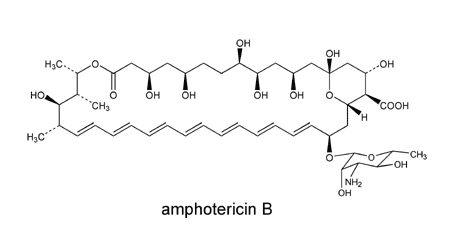Trade & Generic Names & General Features
Amphotericin B colloidal dispersion (ABCD) is a lipid formulation of amphotericin B. As with the other lipid formulations, the major goal of developing ABCD has been to attain a compound with lower toxicity and with at least similar efficacy compared to the parent compound, amphotericin B deoxycholate.
ABCD is composed of amphotericin B complexed with cholesteryl sulfate. It is a disk-like structure [939, 1044]. ABCD is being manufactured by Sequus Pharmaceuticals (Menlo Park, CA, USA) under two trade names, Amphocil™ and Amphotec™.
ABCD displays two-compartment pharmacokinetics. After infusion, it is rapidly removed from the blood by the reticuloendothelial system and then re-released to the circulation. Plasma clearance and volume of distribution increase with escalating doses of ABCD [58, 728]. Compared to the conventional amphotericin B deoxycholate preparation, peak serum levels are lower with ABCD. The amount of amphotericin B bound to the low-density lipoprotein (LDL) fraction is also lower after administration of ABCD in comparison to amphotericin B deoxycholate [728].
ABCD achieves high concentrations in liver. However, its concentrations in kidneys, spleen, brain and lungs are lower than that of amphotericin B [2020].

Mechanism(s) of Action
The mechanism of action and intrinsic antifungal activity of ABCD is the same as the parent compound, amphotericin B [1729, 2232].
The significance of susceptibility testing for ABCD, as for that of any of the lipid formulations of amphotericin B, is not known. This is mainly due to the fact that the enhanced activity of lipid formulations of amphotericin B follows from the lesser toxicity of the lipid preparation. This permits administration of increased doses of amphotericin B and, presumably, increased delivery of active drug to sites of infection.
Nevertheless, comparative results have been reported. For Aspergillus spp., the ranking of the in vitro activity of amphotericin B and its lipid formulations has been reported as amphotericin B deoxycholate = ABCD > L-AMB > ~ ABLC [1668]. As for the Candida spp., while ABCD MICs have been found to be higher than those of amphotericin B deoxycholate for C. glabrata, C. krusei, C. kefyr, C. tropicalis, C. lusitaniae, and Cryptococcus neoformans, those for C. albicans have been found to be similar with both formulations [981, 1129]. Further work is needed to support the relevance and clarify the meaning of these data. In the interim, we believe that testing should simply be done with amphotericin B, the parent compound.
For susceptibility patterns of amphotericin B, see amphotericin B. For ABCD MICs obtained for various types of fungi, see susceptibility patterns and the N/A(L):susceptibility database.
Usual Doses
ABCD is in general administered at doses of 3- 6 mg/kg [70, 632, 1691]. Doses as high as 7.5 mg/kg have been safely used [311, 958].
Side-Effects
Similar to the other lipid formulations, nephrotoxicity due to ABCD is less frequent compared to amphotericin B deoxycholate. This is presumably due to lower peak serum levels and less LDL-bound amphotericin B with ABCD compared to that with parent compound [728].
One of the major disadvantages is the higher incidence of acute infusion-related toxic reactions (hypoxia and chills) due to ABCD compared to the other lipid formulations [2424]. Tolerance of other formulations of amphotericin B does not guarantee tolerance of ABCD. Decreases in systolic blood pressure, worsening of mental status, increase in serum creatinine level and white blood cell count, and severe acute onset rigors were also been reported in a patient whose therapy was switched from ABLC to ABCD [1133].
Routes
ABCD is administered intravenously.
ABCD is licensed to be used in treatment of invasive fungal infections when amphotericin B therapy fails or is unacceptably toxic [1729]. It is not a first-line drug for any of the fungal infections. Preliminary data on its use as an empirical therapeutic agent in febrile neutropenia are promising [2423]. Its potency in different clinical settings is under continuing investigation. However, the higher incidence of acute toxic reactions due to ABCD appears as a significant drawback and limits its clinical use compared to the other lipid formulations.
Please also see our discussion on cost analysis and pharmacoeconomic analysis of antifungal therapy.
